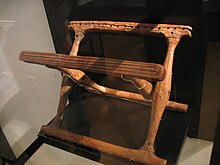Folding chair
This article needs additional citations for verification. (February 2018) |

A folding chair is a type of folding furniture, a light, portable chair that folds flat or to a smaller size, and can be stored in a stack, in a row, or on a cart.
It can be combined with a folding table.
Uses
[edit]
Folding chairs are generally used for seating in areas where permanent seating is not possible or practical. This includes outdoor and indoor events such as funerals, college graduations, religious services, and sporting events and competitions.
Folding chairs are also used in the home for any situation requiring extra seating. This includes parties, card games, and temporary seating at the dinner table. It can be combined with a folding table.
History
[edit]


Folding chairs or stools were used as seating in the Mediterranean area in the 15th–13th century BC.[2] The chairs were also used as grave goods in the richest graves. A folding chair of ebony and ivory with gold fittings was found in Tutankhamun's tomb in Egypt.
Folding chairs were already used in the Nordic Bronze Age, Ancient Egypt, Minoan Greece and Ancient Rome. The frame was mostly made of wood, and seldom made of metal. The wood was inlaid with artistic carvings, gilded, and decorated with ivory. In Northern Europe, the remains of more than 18 folding chairs are known dating back to the Nordic Bronze Age such as the Daensen folding chair and the Guldhøj chair, found near Vamdrup, Denmark.[3]
The folding chair became widespread during the Middle Ages. Folding chairs called faldstools were treasured as liturgical furniture pieces, used by bishops when not residing at their own cathedral. Since the 15th and 16th centuries folding chairs often had arm and head rests.[citation needed]
In the United States, an early patent for a folding chair was by John Cram in 1855.[4] On July 7, 1911, Nathaniel Alexander patented a folding chair[5] whose main innovation was including a book rest.[6] In 1947, Fredric Arnold created the first aluminum folding chair with fabric strapping for the seat and back. By 1957, the Fredric Arnold Company of Brooklyn, New York, was manufacturing more than 14,000 chairs per day. Today, folding chairs are mostly made of hard plastic, metal, or wood.
Design
[edit]Folding chairs typically weigh from 2 to 5 kilograms (4.4 to 11.0 pounds) and are produced in a variety of styles, folding mechanisms, and materials.
Lawn chair
[edit]A common form of folding chair is often referred to as a lawn chair. It typically consists of a collapsible frame with a fabric covering. They are often used outdoors at sporting events and parks.
Leg pivoting
[edit]Folding chair legs can pivot to fold either under the seat, or at the seat.
Most folding chairs pivot at the seat level. The seat aligns between the back supports. The back support and the front legs are the same part. There are, however, several designs that fold under the seat. Side-X stools consist of two X-shaped pieces with a sheet of cloth between them that becomes the seat. Front-X chairs are similar to side-X stools, but have the addition of a backrest. Side-X chairs are unique because the support for the backrest and front foot is the same part. The seat is collapsed to align between the sidebars, either down between the front legs, or up to align between back-sidebars. Mechanisms vary, but the supports for the back and the front feet are invariably the same part.
Pricing
[edit]
Prices and quality can be roughly divided into four categories, and are largely the same as for stacking chairs:
Low range
[edit]This light and inexpensive furniture is usually made from steel tubing, with a plastic seat and backrest. This style is very common in homes, churches, schools, and community events.
Mid-range
[edit]These are sturdy and a greater variety in styles and materials. They are typically not upholstered. They cost from approximately $25 apiece (2008). Their primary use is seating for large arenas, outdoor or places of worship, but also cafes and brasseries.
Upper range
[edit]These folding chairs are often multiple reinforced, and come with padded seats and backrest. These are mainly sold for sporting events. The seat is sometimes made to fall backward so that it stands upright, making rainwater run off the upholstered seat.
High end
[edit]Folding chairs in this category cost upwards of $150 apiece. The reason for the high pricing is because of the more expensive materials used which may mean some are They may be upholstered.[7]
In popular culture
[edit]Specifically modified and lighter folding chairs are used as weapons in professional wrestling. The investigation into Chris Benoit's death cited chronic traumatic encephalopathy, which is often caused by chair shots to the head and other related concussions as a leading cause of his symptoms. Chair shots to the head are now banned in the WWE and All Elite Wrestling, and the use of chairs was reduced to prevent injury.[8]
See also
[edit]References
[edit]- ^ A folding chair from the Bronze Age National Museum of Denmark
- ^ "The chair as status symbol". National Museum of Denmark. Retrieved 2023-08-08.
- ^ Anders Otte Stensager (14 December 2003). "»My name is Boye, I dig carins and old mounds« The archaeologist Vilhelm Christian Boye". KUML (in Danish and English). 52 (52): 35–80. doi:10.7146/KUML.V52I52.102638. ISSN 2446-3280. Wikidata Q120968935.
- ^ Patent US 0013479 A, Folding Chair
- ^ US997108A, Alexander, Nathaniel, "Chair", issued 1911-07-04
- ^ Bellis, Mary (July 28, 2019). "Biography of Nathaniel Alexander, Inventor of a Folding Chair". ThoughtCo. Retrieved 2023-08-08.
- ^ p-themes. "COZONI Tuffy Folding Chair (Smoke Orange)". COZONI. Retrieved 2024-06-26.
- ^ Hausman, Nick (2023-07-13). "AEW Reportedly Bans Moves And Institutes New Rules". Retrieved 2024-06-26.
